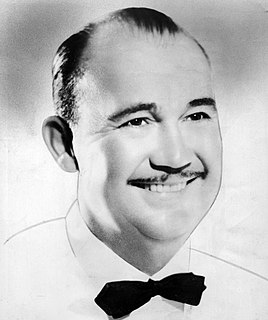
Paul Samuel Whiteman was an American bandleader, composer, orchestral director, and violist.

Rhapsody in Blue is a 1924 musical composition written by George Gershwin for solo piano and jazz band, which combines elements of classical music with jazz-influenced effects. Commissioned by bandleader Paul Whiteman, the work premiered in a concert titled "An Experiment in Modern Music" on February 12, 1924, in Aeolian Hall, New York City. Whiteman's band performed the rhapsody with Gershwin playing the piano. Whiteman's arranger Ferde Grofé orchestrated the rhapsody several times including the 1924 original scoring, the 1926 pit orchestra scoring, and the 1942 symphonic scoring.
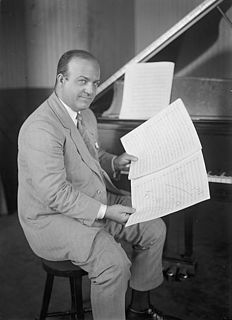
Ferdinand Rudolph von Grofé, known as Ferde Grofé was an American composer, arranger, pianist and instrumentalist. He is best known for his 1931 five-movement tone poem, Grand Canyon Suite, and for having orchestrated George Gershwin's Rhapsody in Blue prior to its 1924 premiere.
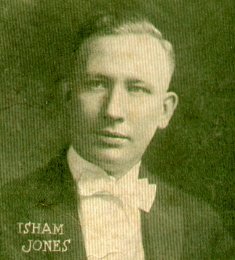
Isham Edgar Jones was an American bandleader, saxophonist, bassist and songwriter.
"Oh, Lady Be Good!" is a 1924 song by George and Ira Gershwin. It was introduced by Walter Catlett in the Broadway musical Lady, Be Good! written by Guy Bolton, Fred Thompson, and the Gershwin brothers and starring Fred and Adele Astaire. The song was also performed by the chorus in the film Lady Be Good (1941), although the film is unrelated to the musical.
Nadine Dana Suesse was an American musician, composer and lyricist.

"Washboard Blues" is a popular jazz song written by Hoagy Carmichael, Fred B. Callahan and Irving Mills. It was first recorded for Gennett Records in May, 1925 by Hitch's Happy Harmonists with Carmichael on piano. It was subsequently recorded by jazz bands Original Memphis Five (1925) and Red Nichols and his Five Pennies (1926).

"Wonderful One" is a popular song recorded by the Paul Whiteman Orchestra on January 25, 1923 in New York and was released as Victor 19019-B. The record reached no. 3 on the Billboard chart. The song was also recorded as "My Wonderful One".

"Hot Lips" or "He's Got Hot Lips When He Plays Jazz" is a popular song written by jazz trumpeter Henry Busse, Henry Lange, and Lou Davis. The song was a number one hit for Paul Whiteman and His Orchestra. Henry Busse was a founding member of the Paul Whiteman Orchestra, joining in 1918.

"Whispering" is a popular song. "Whispering" was first published in 1920 by Sherman, Clay & Co., of San Francisco. The initial 1920 copyright and first publishing attributes the lyrics to Malvin Schonberger and the music to John Schonberger.

"Three O'Clock in the Morning" is a waltz composed by Julián Robledo that was extremely popular in the 1920s. Robledo published the music as a piano solo in 1919, and two years later Dorothy Terriss wrote the lyrics. Paul Whiteman's instrumental recording in 1922 became one of the first 20 recordings in history to sell over 1 million copies.

"Livery Stable Blues" is a jazz composition copyrighted by Ray Lopez (né Raymond Edward Lopez; 1889–1979) and Alcide Nunez in 1917. It was recorded by the Original Dixieland Jass Band on February 26, 1917, and, with the A side "Dixieland Jass Band One-Step" or "Dixie Jass Band One-Step", became widely acknowledged as the first jazz recording commercially released. It was recorded by the Victor Talking Machine Company in New York City at its studio at 46 West 38th Street on the 12th floor – the top floor.
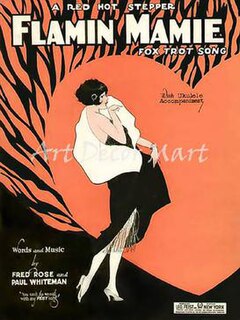
"Flamin' Mamie" is a 1925 jazz classic composed by Paul Whiteman and Fred Rose.
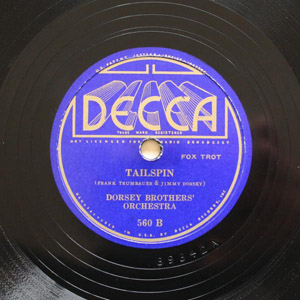
Tailspin is a 1934 song written by Jimmy Dorsey and Frankie Trumbauer. The song was released by Paul Whiteman and His Orchestra featuring Frankie Trumbauer in 1934 on Victor and by The Dorsey Brothers Orchestra in 1935 as a Decca single.

"When the One You Love Loves You" is a 1924 composition by jazz musician and bandleader Paul Whiteman. The song was released as a 78 single by Paul Whiteman and His Orchestra.

"Whiteman Stomp" is a 1927 jazz composition by musician and bandleader Paul Whiteman, Fats Waller, and Jo Trent. The song was released as a 78 single by both Paul Whiteman and Fletcher Henderson.

"Wang Wang Blues" is a 1920 jazz composition written by Henry Busse, Gussie Mueller, and Theron E. "Buster" Johnson, with lyrics by Leo Wood. The song was released as a 78 single by Paul Whiteman and his Orchestra featuring Henry Busse on trumpet. The song is a pop and jazz standard.
Larry Wagner was an American arranger, composer, and bandleader. He worked for the band of Paul Whiteman and was long associated with Glen Gray and the Casa Loma Orchestra. His compositions "Whistler's Mother-in-Law", "No Name Jive" and "Turn Back the Hands of Time" became nationally popular.
Julián Robledo (1887–1940) was a composer best known for the song "Three O'Clock in the Morning". Robledo lived in Buenos Aires, Argentina in the early 1900s where he played piano in tango orchestras and composed some of the earliest published tangos. "Three O'Clock in the Morning" was published in the United States in 1919. The song was recorded by Paul Whiteman in 1922 and became one of the first 20 recordings in history to achieve sales of over one million records. The piece features prominently in the December 27, 1950 episode of radio's The Harold Peary Show.















